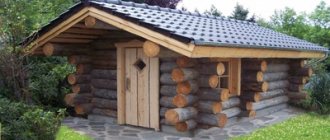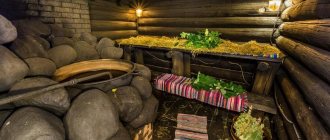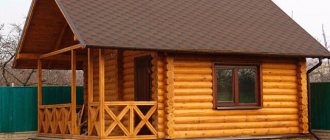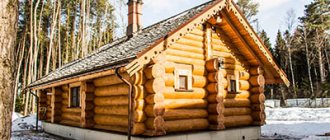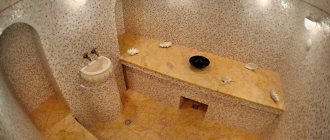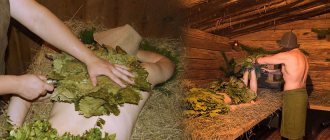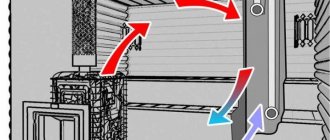SHARE ON SOCIAL NETWORKS
FacebookTwitterOkGoogle+PinterestVk
Today, a real Russian bathhouse is considered not only a luxury item and a tribute to fashion, but is also an integral part of a healthy lifestyle. The structure for bath procedures can be made from any building material, but it can only become a real health resort from wooden products. Log baths are a classic embodiment of a real Russian tradition, where you can not only relax, but also get a real charge of vivacity and health.
You can build a log bathhouse with your own hands or order turnkey construction from a specialized company
Features and advantages of a log bath
Today there are many designs for log baths, and the price of construction primarily depends on the building material. When constructing log bathhouses, debarked or rounded logs can be used. The first option is represented by products in which the top layer is missing, but the structure is not damaged. This is a more durable material. The surface of rounded logs is leveled to a certain size along the entire length in the factory.
If you purchase ready-made logs of the required size from the manufacturer, you can build a bathhouse quite quickly
The construction of a bathhouse from logs has a number of advantages:
- walls made of logs easily allow air and steam to pass through, leaving warmth and the unique aroma of wood inside the room for a long time;
- The wood contains natural resins, which have a tonic and healing effect for the human body;
- due to the light weight of the logs, there is no need to build a massive foundation;
- a log house, due to its natural layer of subcortex, does not accumulate moisture and is not susceptible to rotting, mold formation or damage by insects;
- log frame is a natural, healing and environmentally friendly material, which allows the walls of the bathhouse to “breathe”;
- the process of constructing a bathhouse from a log is quite fast and easy, which became possible thanks to high-quality processing of products and adjusting them to the required dimensions;
- due to the fact that well-fitted products fit tightly to each other during the construction of the bath, without leaving significant gaps, maximum heat retention inside the room is ensured, which allows saving energy resources;
- Using rounded logs, you can implement any architectural project.
The quality of construction of a log bathhouse directly affects the service life of the building
Log baths have disadvantages. However, they directly depend on the approach to construction. A log sauna should be built exclusively from dried wood. If the products are damp, they will shrink over time, which will cause longitudinal cracks to appear. The construction of a bathhouse from rounded logs should be carried out by a specialist in this field in order to ultimately obtain a strong and durable structure with all of the above advantages.
Shrinkage
When freshly cut, wood contains a significant amount of moisture. Free moisture is found in wood cavities. Leaving the material, it does not affect its shape and linear dimensions. Bound moisture is another matter - that which is present in the thickness of the cell membranes. Its content in wood reaches up to 30% and removal entails warping, cracking and shrinkage (reduction in linear dimensions) of the timber.
During construction, you will have to add 5–7 cm for each meter of height to the expected height of the bathhouse from the log house. The allowance for sedimentary deformation is also included in the height of door and window openings. The gap above the box is temporarily filled with insulation, and after two years it is caulked or covered with an additional element (if the shrinkage turned out to be less than expected).
Installation of internal partitions (non-shrinkable) and cladding are timely only one to two years after the construction of the log bathhouse for shrinkage from logs. The period of “rest” depends on the size of the log house and the weather.
For a small bathhouse, 10–11 months of settling may be enough - if construction began after the autumn rains and the summer was dry.
Attention! The gap between the partition and the ceiling is required even after drying, at least 1-2 centimeters.
Horizontal shrinkage - along the wood fibers - is only a few tenths of a percent, so when building a log bathhouse, no attention is paid to lengthwise shrinkage.
A bathhouse can be built from brick, but many people see a log house as a “historically correct” solution.
If you say the word “bathhouse”, then most likely an image of a log house will appear.
In order for log houses and bathhouses to serve for a long time, the work of professional carpenters, assemblers, roofers, healthy timber and their competent processing are needed. Proper use will prevent early cracking and twisting of the wood.
How to choose material for a log bathhouse
For the construction of a log bathhouse, pine or spruce are mainly used, less often - aspen, linden and alder.
Due to the presence of a large amount of resins, pine does not rot or crack during drying. It is easy to process. The trunk of mature pines is almost even along its entire length, and the branches are located only at the top. Two types of pine are used for construction: resin and dry chips. The first option is used for the construction of the lower crowns, and the second - for the upper ones.
To build a pine bathhouse, two types of wood are used: resin and dried wood.
Spruce is a more difficult species to process due to its knotty nature. It is not recommended to use it for self-construction of a bathhouse. Also, aspen is often used for log houses, which grows today in sufficient quantities and resists moisture well. However, you should choose specimens no older than 45 years, which have a low probability of core rotting.
Linden has proven itself well. However, it is rare and has a high cost. Oak is often used for the lower crowns, which is not afraid of moisture and protects this area of the bathhouse from rotting. But this is a very expensive material, and without proper experience in construction it is inappropriate to use it. This can lead to significant losses. In this case, it is better to order a turnkey bathhouse made of rounded logs.
Helpful advice! For a bathhouse, it is better to choose rounded logs from coniferous wood growing in the northern part. The products have a denser structure and do not change their natural properties due to increased humidity levels and temperature changes.
When building a bathhouse in humid regions of the country, it is better to use oak logs
Criteria for selecting quality material
Preparation of logs is carried out in the winter months, which allows us to obtain the most moisture-resistant building material. The logs are felled, the bark is trimmed from them and the branches are cut off with an ax or plow. At this stage, the material is rejected. Products with high density and a diameter of at least 25 cm are selected. Logs cannot be used for construction:
- with unnatural color and spots on the cut;
- having too large a core;
- curved or with a sharp thickening;
- knotty with cavities in the locations of the knots.
Rounded logs are manufactured in a factory. The product is aligned in diameter and length. The entire surface of the wood is impregnated with an antiseptic to protect the product from rotting, and the cuts are treated with a special compound.
When purchasing logs for building a bathhouse, it is important to check the quality of the wood on cuts.
Rounded logs are produced with grooves for laying, the shape of which can be Finnish, lunar or crescent-shaped.
When choosing a rounded log, you should pay attention to the following factors:
- the surface of the product should be light or dark yellow;
- the branches should be located inside without gaps, which indicates a loose core;
- the cut surface of the log must be hard;
- the core should be a dark, even shade, with a diameter of less than three-quarters of the cut;
- If the product is not over-dried, when it hits its surface with the butt of an ax, it will make a ringing sound.
Helpful advice! To get the warmest possible room, you should choose thick rounded logs, at least 250 mm thick, for building a bathhouse.
To build a two-story bathhouse of complex architecture, it is better to use the services of specialists
Conclusion
Now you know how to choose the optimal diameter of a log for permanent residence, so that you feel cozy and comfortable in your home. But I would like to remind you that the building has many places that are sources of heat loss, even if you choose a log house of the required size. These elements include door and window openings, because a lot depends on the quality of the product!
In order for the house to be warm, you need to take into account a lot of specific points at the design stage: floor, walls, ceilings, basement (if any), openings
In the video presented in this article you will find additional information on this topic.
Types of log bathhouses
There are two main types of log house: “in the oblo” and “in the paw”. The first option is easier to implement and the most popular. However, more material consumption is required here due to the fact that the logs on each side protrude 25 cm beyond the corner. But thanks to this technology, it is possible to create a warmer room and reliably protect its corners from the wind.
Each log is adjusted before being placed in the clapboard, or bowl. Here a rounded groove is cut out, no less than a third of the thickness of the trunk. The lower the temperature in the region, the deeper the excavation should be. Each subsequent log is placed in a previously prepared thicket.
There are several other varieties of this technology. In a log house, the logs are turned over with the notch down, focusing on the product laid below. This allows precipitation to flow freely from the logs without getting into their thickness. The result is a more reliable and durable structure.
The type of log house “in the oblo” is easier to implement and the most popular
With Canadian felling, a trapezoidal notch with a tenon is created in each log from below, and a groove for the tenon is made on top. This technology allows you to create the maximum effect of jamming connections.
Norwegian log house is made from products with hexagonal processing or oval section. The technology is completely identical to the Canadian log house.
The appearance of the ends of the Swedish log house differs significantly from other technologies. This is a very painstaking and time-consuming process. The protruding ends of the log and the recess are trimmed to a hexagon shape. As a result, it is possible to obtain a unique, aesthetically striking structure.
The most economical is the “paw” method. However, this requires great skill of the performer. The corners in such a log house turn out to be cold, which requires the creation of additional thermal insulation, and, consequently, further cladding with facing material. After reviewing the photos of log bathhouses, you can choose the most suitable option for construction.
The option of a log house “in the paw” is more economical but requires work experience
Preparing a working draft
It is recommended to build a bathhouse 15 meters from a wooden house
Design is carried out taking into account the following parameters.
Placement - the log house is located at least 15 m from the residential building or at least 10 m if the house is concrete or stone. Choose an elevated location, as this makes it easier to remove moisture. It is better if the building is protected from the winds by bushes and trees or a fence. In a small bathhouse they plan only a steam room and a vestibule. The washing room can be combined by arranging a bucket or ladle for dousing, or place it under a canopy
If the space allows, they plan a steam room, a washing room, a locker room, and possibly a guest room. It is important to design effective ventilation. Otherwise, the building will become damp. When planning, take into account the size of the log
It is necessary to calculate where they will be joined, what is the permissible length of the wall, etc.
The use of rounded and planed logs significantly simplifies the design.
Foundation for the construction of a Russian log bath
The key to the strength of the entire structure is a properly selected and equipped foundation. The minimum depth of its laying depends on the depth of soil freezing, to the value of which at least another 1 m is added. This value is individual for each region, but on average it is 0.5-1.2 m.
For a bathhouse, you can arrange one of three foundations: strip, columnar or pile. This depends on the characteristics of the soil where the structure will be located.
If the soil consists of quartz, rock or fine sand, any type of foundation can be constructed. For swampy, garden, forest, clay, loamy soil, it is better to make a strip foundation. For this purpose, a trench of the required depth is dug, into which a layer of sand of about 150-200 mm is poured. Next, a layer of crushed stone is laid on which the reinforcement is placed and concrete of a grade not lower than M200 is poured.
The choice of the type of foundation for building a bathhouse depends on the type of soil and the size of the building
If the bathhouse will be located on a slope or on heaving soils, preference should be given to a pile foundation made of metal or concrete piles. For small baths, a columnar foundation made of concrete blocks, brick or stone is suitable. The depth of the columns can be 0.7-1 m, which are installed along the entire perimeter of the bathhouse in increments of at least 2 m.
After erecting the foundation, it is necessary to waterproof it using special materials. Next, an additional barrier is created for moisture that can be released from the surface of the base. Its role is played by backing boards measuring 50x150 mm, made of larch, which are attached to the concrete with anchor bolts.
Related article:
Bathhouse projects with a gazebo under one roof: the best ideas for implementation
Features of the structure and an overview of the best options for implementation. Recommendations for construction. Original planning ideas.
Building area
Ideally, each bathhouse visitor should have from 1.3 to one and a half square meters of space in the dressing room or 1 m2 in the steam room. The optimal washing area for one person is 2.25-2.4 sq.m. More than 80 cm of free space should be left between the shower stall (or a bench in a soap room, the dimensions of the bench are 0.5 x 0.9 meters) for ease of movement. In fact, this area can be slightly increased for greater comfort.
The optimal usable area of a bathhouse for 2-3 people with three rooms (shower room, dressing room and the steam room itself with an area ratio of 1.5: 2: 1) is approximately 10 square meters.
How do you know if the planned area will be enough for you? The easiest way is to outline all the walls and partitions in steps. In winter, it is better to do this in the snow, and in summer, mark with sand or pull ropes.
“Tread down” the dimensions of the future bathhouse on the snow
Features of building a bathhouse with your own hands from debarked logs
Construction of a bathhouse is a very labor-intensive process, especially if debarked logs are used. If you do not have the proper experience in construction, it is better to entrust this matter to specialists who can build a turnkey bathhouse from logs. The price of a log house will depend on its dimensions and functionality.
The debarked log undergoes minimal external processing, which ensures high strength of each element and the entire structure
The traditional method is to lay logs on the foundation with the north side facing outward, on which the growth rings are located. It is this part that can withstand significant temperature changes and other adverse weather conditions. Since the lower part of the building is most susceptible to moisture and the proliferation of microorganisms on its surface, the first crown is laid from the thickest and largest products. They must be free of defects and have a high resin content.
Helpful advice! To ensure the building is strictly horizontal, it is necessary to correctly unravel the first crown, i.e., align it in height.
For the embedded crown, the first two logs are laid on the foundation from opposite sides parallel to each other. Holes in the form of bowls are hewn out in the products, into which the next two logs are laid perpendicularly. All subsequent crowns are laid in this way.
The qualifications of the craftsmen when building a bathhouse from debarked logs is an important factor, since due to the uneven surface of the wood it is quite difficult to fit the logs tightly
The logs for laying each subsequent crown should be approximately the same diameter. Here you should alternate between thin and thick sides of the products to prevent distortion of the structure. A heat-insulating material is placed between them, which is attached to the frame using staples, which prevents blowing through the joints of the products. It can be moss, hemp, linen tow, felt or jute.
To add strength to the structure, every one and a half meters it is necessary to fasten the crowns with pins. The topmost crown is called the Mauerlat, on which the roofing system is installed. After completing the construction of the bathhouse, you should begin caulking it. You need to start from the bottom crown, moving around the circle of the building. This is how each next crown is sealed. Upon completion of the work, the log house will look a little higher. But after some time it will shrink, and the building will acquire its original dimensions.
Important! If you immediately caulk one wall completely, the frame of the bathhouse may become warped.
After the walls are erected, they begin installing the rafter system and laying the roofing material. In this form, the log house remains until next year to allow the logs to dry out, after which the structure will finally settle. Only after this will it be possible to begin facing work. You can build an inexpensive turnkey log bathhouse starting from 200 thousand rubles.
The cost of building a log bathhouse depends on the size and complexity of the structure's layout.
What should be the thickness of the walls?
The thickness of the log for the log house depends on how the building is intended to be used: for permanent or temporary residence. In addition, this parameter depends on the climatic conditions of the region: in severe frosts, a log that is too thin will freeze, and a large amount of fuel will have to be spent for heating. The thickness of the log walls for central Russia is determined as follows:
Logs less than 18 cm thick can only be used for non-residential structures. These are gazebos, workshops, outbuildings.
- A country house can be built from logs 20-22 cm thick. Such a building will be designed for summer living, in addition, it will be comfortable in spring and autumn with proper insulation.
- The thickness of a log house for permanent residence is 22-30 cm. This is a fairly expensive solution, but purchasing logs at a high price will allow you to save on purchasing fuel for heating in the future.
- A log 30-40 cm thick is the most reliable, warm and durable option, which, however, will be very expensive. However, you need to take into account that less logs will be required for the construction of walls due to the increased thickness, so the difference in price will be less significant.
If finances allow, you can build a building from thicker material. Economically, this is not the most profitable solution, but the house will be truly strong and as durable as possible.
In addition, a building made of thick logs looks very beautiful: it is a powerful structure that will become a real fortress and can last for many years. The large thickness of the log house also allows you to save on insulation work, since the material itself retains heat well.
If you want to build a log house, the thickness of the walls is not the only parameter that directly affects the energy efficiency of the building
Most of the heat escapes through the openings of doors and windows, so it is important to take care of the correct installation of window and door units. If a large glazing area is expected, you will have to purchase two- and three-chamber double-glazed windows, and all seams in any case will need to be carefully closed and insulated
What should a log bathhouse look like?
A special question is: what should be the thickness of a log house for a bathhouse? This room should be warm, since both the comfort and benefits of bath procedures will depend on this. At the same time, the bathhouse is not used constantly, and some do not use it at all in winter, so it is not advisable to spend too much on purchasing lumber.
For the conditions of central Russia, the optimal thickness of the walls of a log bathhouse is 20-25 cm. This will be enough to maintain a comfortable atmosphere inside the bathhouse, while the material is sold at an affordable price. In any case, when building a bathhouse, you will have to spend money on the purchase of insulation: it is necessary to lay inter-crown rolled material when constructing the walls, in addition, the ceiling and floor require mandatory insulation.
Savings when buying logs for a log house leads to the fact that in the future you will have to constantly spend money on energy resources: the bathhouse will have to be heated for a very long time, and it will begin to cool down very quickly. All this will lead to an insufficient level of comfort, and the building will require additional insulation.
Features of constructing a bathhouse from rounded logs
The construction of bathhouses from rounded logs is much faster and easier, since the products are manufactured in a factory, where they are given a certain shape and size. All of them are numbered and have grooves for easier installation.
However, you should know that products are produced for certain bathhouse projects made of rounded logs, which are presented in the catalogs of woodworking enterprises. From the options presented, you can select the most suitable one and place an order for the manufacture of products. After receiving the kit, there will be no problems assembling the bathhouse. Detailed instructions are also included with the log house.
When building a bathhouse from rounded logs, certain requirements must be observed:
- for better contact with the foundation, the casing crown should be trimmed from the bottom side;
- since the logs lost their protective layer during processing, all products must be impregnated with a fire-retardant agent;
- For vertical stability of the structure, it is necessary to connect the logs with dowels made of hard wood of oak, beech or birch, which are recessed into the product by at least 3 cm;
- holes for dowels should alternate in a checkerboard pattern along the entire length and height of the wall in increments of 0.8-1.2 m and a length of 2-3 crowns;
The rounded log has undergone mechanical processing in production and therefore has the same diameter along its length, as well as ready-made grooves, which greatly facilitates the construction of a bathhouse
- before drilling holes for the dowels, the logs should be secured using temporary nails, which are removed after connection;
- Between the products, heat-insulating material in the form of tow or flax fiber must be placed, which is secured with staples;
- the construction of each subsequent crown must be controlled using a level to avoid distortion of the frame;
- to prevent the destruction of door and window frames during shrinkage of the log house, the openings are framed with casing beams with a gap of 3% of the height of the opening, which is filled with insulation.
Shrinkage
When freshly cut, wood contains a significant amount of moisture. Free moisture is found in wood cavities. Leaving the material, it does not affect its shape and linear dimensions. Bound moisture is another matter - that which is present in the thickness of the cell membranes. Its content in wood reaches up to 30% and removal entails warping, cracking and shrinkage (reduction in linear dimensions) of the timber.
During construction, you will have to add 5–7 cm for each meter of height to the expected height of the bathhouse from the log house. The allowance for sedimentary deformation is also included in the height of door and window openings. The gap above the box is temporarily filled with insulation, and after two years it is caulked or covered with an additional element (if the shrinkage turned out to be less than expected).
Installation of internal partitions (non-shrinkable) and cladding are timely only one to two years after the construction of the log bathhouse for shrinkage from logs. The period of “rest” depends on the size of the log house and the weather.
For a small bathhouse, 10–11 months of settling may be enough - if construction began after the autumn rains and the summer was dry.
Attention! The gap between the partition and the ceiling is required even after drying, at least 1-2 centimeters. Horizontal shrinkage - along the wood fibers - is only a few tenths of a percent, so when building a log bathhouse, no attention is paid to shrinkage along the length
Horizontal shrinkage - along the wood fibers - is only a few tenths of a percent, so when building a log bathhouse, no attention is paid to lengthwise shrinkage.
A bathhouse can be built from brick, but many people see a log house as a “historically correct” solution.
If you say the word “bathhouse”, then most likely an image of a log house will appear.
In order for log houses and bathhouses to serve for a long time, the work of professional carpenters, assemblers, roofers, healthy timber and their competent processing are needed. Proper use will prevent early cracking and twisting of the wood.
Optimally fast heat
The functional center of the Russian bathhouse is the stove-heater, because it not only heats the premises, but also helps to create proper, light steam, heating the stones intended for watering.
- Alis Photo/Fotolia.com
- "Traditional carpentry technologies"
- "Traditional carpentry technologies"
- The project of a bath complex made of logs with a diameter of 240 mm on a foundation of concrete blocks was implemented in the city of Zheleznodorozhny, Moscow region
- Bathhouse in the village of Tishkovo, Moscow region. The terrace includes a porch, a barbecue area and an open deck
- Spacious bathhouse in the village of Zelenye Dali (Moscow region) - a combination of modern approaches with the traditions of Russian wooden architecture
- Fotoksa/Shutterstock.com
- ID1974/Fotolia.com
- elsar/Shutterstock.com
In a classic Russian bathhouse, the heat generator was a solid, rather large, often wall-length stove on a foundation, which was made of stone or high-quality (without impurities or cracks) brick. The firebox was lined with special refractory bricks. Such furnaces belong to the type of heat-intensive (storage) heat generators. This means that they warm up for a long time, accumulating thermal energy, and then for the same long time (up to a day) they release it into the room, mainly due to radiation. There are stoves that are not heat-intensive, in which these processes occur faster, therefore, to ensure continuous heat transfer, they must be constantly heated, unlike heat-intensive ones, which are heated periodically, replenishing the expended heat. With the development of industrial mass production, the class of constant heating heat generators (continuous) has significantly expanded to include metal furnaces. In their manufacture, various grades of steel are used: low-alloy steel (less than 5% chromium) with a thickness of 5 mm produces heavy, inexpensive stoves; high-alloy steel (over 13% chromium) produces lighter, more durable stoves, but their price is higher.
In modern direct heating (batch) kilns, in addition to brick, materials such as ceramics or potting stone (talcomagnesite), which have a high heat capacity, are used. Such a stove is supplied as a kit (in blocks ready for assembly) or erected “on site” using the masonry method, with each stone adjusted. When using soapstone, its dimensions will be 2–2.5 times smaller than brick, due to the different heat capacity of these materials.
Metal heaters on the market differ in power ratings, which allows you to accurately select a heat generator for a specific room. Depending on the type of fuel used, metal heaters can be wood-burning, gas or electric. Manufacturers of metal stoves try to give them the properties of heat-intensive hearths - by lining them with ceramics or potting stones (for this purpose, typesetting material is used - tiles, panels or a monolith cut for a specific stove model). A gap is left between the lining and the metal body; as a result, the furnace body turns into a channel for the movement of a convection flow of heated air. This makes it possible to heat the steam room and adjacent rooms faster.
To heat water from a sauna stove, a tank-samovar is provided, which is installed on the chimney, or a remote-type tank, heated using a heat exchange register, which was not the case in the classic version of the Russian bath. In addition, among modern sauna stoves there are models with a fuel tunnel, which allows kindling to be made both from the dressing room and from the steam room.
The stove in the steam room is usually placed in such a way that one of its walls heats the adjacent room. The location of the stove is also influenced by the presence or absence of electricity, central heating and network gas. The layout of bath rooms and functional zoning depend on the lifestyle of the bathhouse owner, the nature of his hobbies, personal preferences, the placement of other buildings on the site, etc. Since there are a great many ways to combine these factors into a single functional and meaningful system, the architectural designs of modern Russian baths are distinguished by an individual balance of traditions and new technologies.
Type selection
In order to correctly determine the type of foundation that is guaranteed to last a long time and will perform all the functions assigned to it, it is first necessary to determine the type of soil that prevails at the construction site.
If this procedure has not been carried out before, then in order to independently decide on this issue, you need to drill a hole with a drill up to one and a half meters deep at the site of the proposed construction and carefully examine those fractions that are found in the cross section of the soil.
- The presence of a large number of peat inclusions and damp loose sand indicates that the soil is problematic. Such a foundation is unstable and will be subject to heaving in the off-season, which will lead to horizontal shifts of soil layers relative to each other. In this situation, it is necessary to construct a monolithic or pile foundation, the depth of the supports of which will lie below the depth of soil freezing. It is also acceptable to use a highly buried monolithic strip with reinforced reinforcement, and its depth should also be lower than the level of soil freezing in winter.
- The content of fragments of clay, gravel, and dense dry sand in the soil indicates soil of medium mobility. It is these types of soils that are found in the vast majority of regions of mid-latitudes. Their density is sufficient for the construction of monolithic or columnar strips. In this case, the use of a monolithic slab foundation with a base for the entire structure is impractical and unprofitable.
- If the soil under study has a high content of dense fine sand, rocks, quartz and no clay or loam, then the developer is very lucky. These types of soils are the most elastic, they are not subject to heaving and seasonal shifts, and are ideal for the construction of any structures. However, it is not recommended to use a pile foundation on such soils, since it will be very difficult to drive or screw piles into such dense soil, this process can lead to to damage to the supporting structures themselves. An excellent solution would be to use a columnar or strip base of any type.
Important! To more effectively analyze the soil structure at the construction site, it is recommended to dig several holes in different places on the site. This will allow you to better study the composition of the soil.
Information
If the size of the bathhouse exceeds the linear length of the construction material on each side, for example, the length of a wooden beam (usually 6 m), the most practical option would be to construct a recessed strip foundation with reinforced reinforcement.
A monolithic support in the form of a slab will be irrational due to the high consumption of material.
And when using a columnar base, there is a high risk of skewing of individual supports and, as a result, the bathhouse tilting in any direction.
The choice of foundation type, materials and dimensions should be approached especially seriously, otherwise the entire construction could go down the drain.
Tips for the builder
Foundation
Log houses are usually built on one of four types of foundations. The strip base can be prefabricated or monolithic. In the first case, FBS concrete blocks are used for assembly, laid on a gravel-sand backfill and concrete preparation up to 100 mm thick with ligation of vertical seams.
In the second, the tape is poured after laying it in a previously opened trench of the reinforcing frame; Before pouring, the walls of the trench are covered with polyethylene or roofing felt.
A high base requires the installation of additional formwork.
The foundation on bored piles involves drilling wells with a diameter of 300-400 and a depth of 1 - 2 meters. The walls of the wells are waterproofed with roofing felt rolled into a pipe; then a reinforcing frame is lowered into the well, after which it is concreted with mandatory bayonet or vibration compaction.
A screw foundation uses steel pipes with welded or cast tips, reminiscent of a ship's propeller, screwed into the ground with considerable force as supports. This type of foundation can be used on swampy or clayey soils. It transfers the pressure of the building's mass to the denser underlying layers of soil.
Screw foundation with wooden grillage.
Finally, the undoubted leader in cheapness of execution is the columnar foundation.
The instructions for its construction are extremely simple:
- 8-10 cm of low-quality concrete (concrete preparation) is laid out on the sand bedding;
- Brick pillars or pillars assembled from concrete blocks measuring approximately 400x400 - 500x500 mm are erected on it;
- The surface of the pillars is waterproofed, after which a wooden grillage or the first crown of the log house is anchored to them.
A jute tape is laid between the grillage or strip foundation and the first (tying) crown. It is also used to seal all other inter-crown connections.
